Best cities in South Florida for empty nesters
Once children have left home, parents often look for more comfort, convenience, and access to leisure. Best cities in South Florida for empty nesters offer an appealing mix of climate, lifestyle, and services that support that shift. Warm weather allows year-round outdoor activities, while access to three major airports makes travel simple. Also, downsizing is easier here, thanks to reputable Miami movers, the range of condos, 55+ communities, and single-level homes tailored to active adults.
Quick criteria for choosing your city
Not all South Florida cities meet the same needs, so it helps to weigh key factors before deciding. Empty nesters often prioritize affordability, access to healthcare, and lifestyle fit. Those moving from larger family homes also need to evaluate housing types that match their new stage of life.
Key points to review include:
- Budget and local property taxes
- HOA and condo rules
- Distance to hospitals and specialists
- Walkability and transit availability
- Noise levels and nightlife intensity
- Hurricane risk and building standards
- Airport access for visiting family
- Insurance costs in flood zones
Hence, looking at these factors early makes it easier to avoid regrets later and ensures the new city matches long-term goals. Also, don’t forget to book local movers in Florida who know condo rules for short in-state moves.
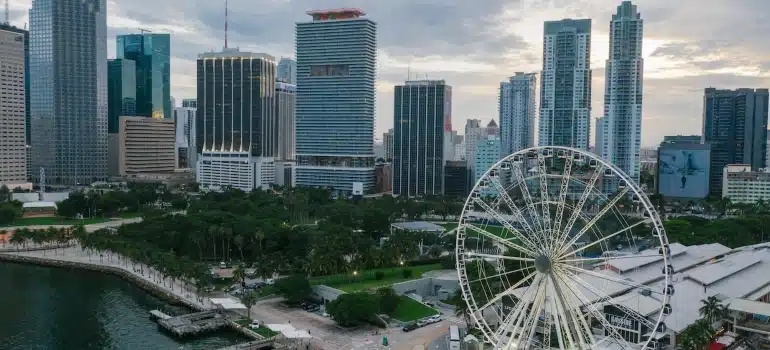
How South Florida cities compare by county
Empty nesters often narrow their search by county, since each offers a different balance of housing, healthcare, and lifestyle. Miami-Dade combines energy and culture, Broward mixes convenience with more suburban comfort, while Palm Beach offers coastal towns with space and stability:
- Miami-Dade County: Miami, Coral Gables, Miami Beach, Aventura
- Palm Beach County: Boca Raton, Delray Beach, Boynton Beach, Palm Beach Gardens, Jupiter
- Broward County: Hollywood, Fort Lauderdale, Weston, Pembroke Pines, Parkland, Coral Springs
The choice often comes down to pace and priorities. Consequently, those who want cultural access and walkability lean toward Miami-Dade. Buyers who prefer organized suburbs with easy airport access usually find Broward appealing. Also, compare quotes from moving companies in Miami-Dade County with the rest before you even pick a building.
Palm Beach attracts those looking for calmer coastal towns and active adult communities. Finally, matching these factors to your own budget and lifestyle is the clearest way to decide which city should be your next home base.
Miami (Coconut Grove, Brickell, and Edgewater)
Miami appeals to empty nesters who want city energy with strong healthcare access. In 2025, the median condo price is $410,000, and single-family homes average $655,000. Condos dominate the market, but buyers should weigh costs carefully. The median HOA fee sits near $900 per month, and new reserve funding rules starting in 2026 will therefore drive many boards to raise dues. Reviewing inspection reports and reserves is essential before committing.
Healthcare is a highlight, with Bascom Palmer Eye Institute ranked number one nationally and major hospital systems like Baptist and Jackson offering top-rated care. Walkability is another plus. Brickell, Coconut Grove, and Edgewater score in the high 80s and 90s, giving residents access to dining, parks, and culture without a car. Miami International Airport adds convenience with nearly 56 million passengers in 2024 and expanded routes.
The downsides are higher insurance costs; condo premiums often exceed $2,300 annually, plus traffic and seasonal congestion. Areas like South Beach, Little Havana, and Overtown are less suitable, as they bring heavier crowds, limited condo amenities, or fewer senior-friendly services. Besides, local movers in Miami handle certificates of insurance and building approvals regularly, making the process easier for newcomers.

Coral Gables
Coral Gables is among the best cities in South Florida for empty nesters who want quieter streets while staying close to city amenities. In mid-2025, the median home price is about $1.1 million, while condos average around $670,000.
Property values remain higher than Miami overall, but the trade-off is stability, strict building codes, and well-maintained neighborhoods. The city’s HOA and local regulations are strong, which helps protect property values but can limit remodeling flexibility. Historic districts enforce unique access rules, so working with movers in Coral Gables helps avoid delays.
Healthcare access is excellent, with the University of Miami Hospital and specialty clinics nearby. The walkable Miracle Mile district provides dining, shopping, and entertainment without long drives. Parks and golf courses add outdoor options, and the overall crime rate is lower than Miami’s urban core.
The drawbacks include higher entry costs and some of the strictest code enforcement in South Florida. Nearby areas like West Miami or Flagami are less appealing, with fewer walkable districts and limited services for older adults. Coral Gables remains a strong choice for those who want a safe, upscale, and well-connected environment.
Miami Beach (Mid-Beach, North Beach, Sunny Isles)
Miami Beach offers oceanfront living, walkable streets, and resort-style condo options, appealing to empty nesters seeking daily leisure. As of mid-2025, the median sale price is about $586,000 across all home types, while the average home value is near $506,000, slightly down year over year. Luxury condos remain in demand, with per-square-foot pricing at record highs.
Many buildings include doormen, fitness centers, pools, and beach access, making them well-suited for downsizers who prefer low-maintenance living. Many oceanfront condos limit elevator hours, though, making Miami Beach movers a smart choice for planning. Wide sidewalks, bike paths, and local cafés add to the appeal.
Healthcare access is strong, with specialists and clinics close by on the mainland. The airport is only a short drive, making family visits and travel simple.
The trade-offs are higher insurance premiums in flood zones, seasonal noise, and congestion from tourists. South Beach and central coastal strips are less practical for empty nesters, as they are busier, louder, and less residential in character.
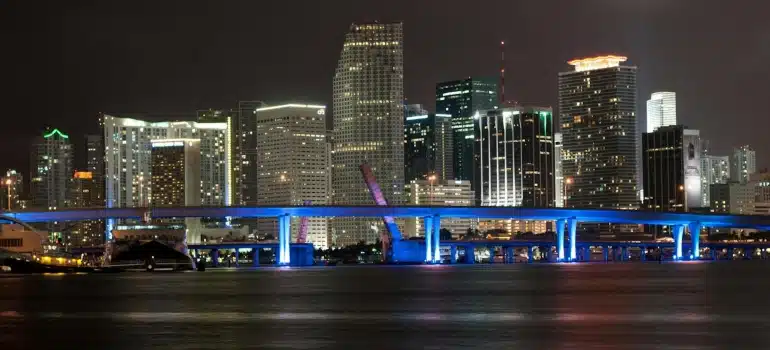
Aventura
Condo living defines Aventura, and that’s what makes it attractive to many older adults planning their next stage. In 2025, the median condo price is around $445,000, and most units come with shared gyms, pools, and security. Large condo communities near the mall are easiest to navigate with movers in Aventura familiar with local logistics.
The city’s flat terrain makes walking easier, and the three-mile Aventura Circle path is a favorite for daily exercise. Immediate access to Aventura Hospital and Medical Center provides peace of mind, something many buyers put at the top of their list.
The drawback is congestion as Biscayne Boulevard and I-95 clog up fast, so those who want quieter surroundings may find it frustrating. North Miami’s condo clusters are less appealing, since they lack the same level of upkeep and medical services close by.
Boca Raton
Boca Raton combines upscale amenities with a steady housing market that fits many empty nesters’ plans. In mid-2025, the median home value is around $546,000, slightly down year over year, while coastal condos often list higher. Communities often feature pools, fitness centers, and 24-hour security, making them convenient for downsizers.
Healthcare and wellness options are excellent, supported by nearby hospitals and specialty clinics. Shopping and dining at Mizner Park and Town Center add to the lifestyle, while beaches and golf clubs provide daily recreation. Central west Boca is less suitable, as it requires longer drives for coastal access and cultural venues.
Delray Beach
Delray Beach offers a smaller-scale coastal city with a lively main street, which suits empty nesters who want energy without Miami’s intensity. In 2025, the median home price is about $386,500, up more than 6% from the previous year. Condos and villas near Atlantic Avenue allow easy access to restaurants, art galleries, and the beach.
It is one of the best cities in South Florida for empty nesters because it supports active living with festivals, outdoor markets, and wellness clubs. Medical facilities are nearby, and larger hospital systems in Boca Raton and Boynton Beach are within a short drive. Outlying neighborhoods west of I-95 are less appealing, as they lack the walkability and coastal atmosphere that define the area.
Boynton Beach
Boynton Beach often comes up when buyers compare cost with coastal access. The median sale price is around $390,000 in 2025, and the city has a long list of 55+ condo clusters with pools, gyms, and social programs. The marina area has been redeveloped, giving residents restaurants and waterfront activity without Delray’s higher costs.
Conditions vary street by street, so choosing the right building is crucial. Lake Worth Beach is nearby but carries more fluctuation in property values and less stability in condo associations.
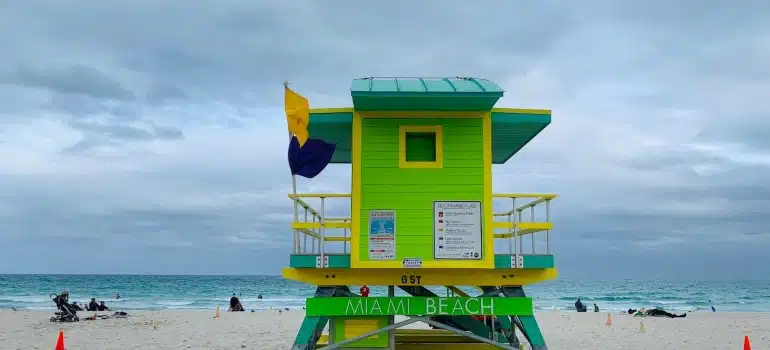
Wellington
Though inland, Wellington is attractive for its open spaces and equestrian culture. Homes here average $680,000 in 2025, with many communities featuring lakes, wide streets, and gated entries. Its hospitals and specialty clinics in Palm Beach County are within a short drive, and parks add to the suburban comfort.
The drawback is the distance to the coast, about 25–30 minutes, which matters if daily beach access is a priority. Royal Palm Beach shares some characteristics but lacks Wellington’s larger planned communities and amenities.
Palm Beach Gardens
Palm Beach Gardens is one of Palm Beach County’s most polished suburban cities, appealing to empty nesters who want comfort with access to recreation. In 2025, the median home price is close to $720,000, though condo and villa options are available at lower price points. Many of the gated communities center around golf and tennis clubs, with amenities like pools, pickleball courts, and fitness centers that support an active daily routine.
Healthcare access is excellent, with Palm Beach Gardens Medical Center and Jupiter Medical Center only a short drive away. That level of care is an important consideration for retirees managing chronic conditions. Retail along PGA Boulevard provides fine dining, grocery stores, and shopping without leaving the city, reducing the need for long commutes. The Gardens Mall anchors the area and adds another layer of convenience.
Jupiter
Jupiter is one of the best cities in South Florida for empty nesters who prefer a coastal town with a slower pace and a strong outdoor lifestyle. As of 2025, the median home price is about $700,000, with condos close to the water and larger single-family homes further inland. Villas and townhomes in gated communities offer lower-maintenance options for those downsizing.
Nature and recreation are central here. The Jupiter Inlet Lighthouse, Carlin Park, and nearby preserves give residents easy access to walking trails, kayaking, and boating. Golf courses and tennis clubs are plentiful, while dog-friendly beaches add to the appeal for pet owners.
Healthcare access is strong, anchored by Jupiter Medical Center, which consistently ranks among the region’s best for cardiac and orthopedic care. Local clinics and urgent care centers reduce the need to travel for routine appointments. Shopping plazas and restaurants are clustered along Indiantown Road, keeping daily errands convenient.
Hollywood
Unlike flashier neighbors, Hollywood delivers a calmer coastal lifestyle. Its median home value in 2025 is about $435,000, with options ranging from mid-rise condos near the Broadwalk to older single-family homes. The downtown arts district provides theaters and galleries in a more approachable scale than Miami.
Condo living is popular here, especially in buildings with pools and gyms, but buyers need to review reserves carefully since many complexes date back to the 1960s and 1970s. The Broadwalk, a seven-mile oceanfront promenade, anchors daily life, providing space for walking, biking, and casual dining. Broadwalk buildings often restrict delivery times, but movers in Hollywood FL know how to work around them.
The downtown arts district brings theaters, murals, and live music, offering cultural activity on a smaller scale than Miami. Memorial Regional Hospital, one of Broward’s largest, is close by for advanced care. Nearby Hallandale Beach tends to feel more transient and casino-oriented, which doesn’t suit everyone looking for long-term stability.
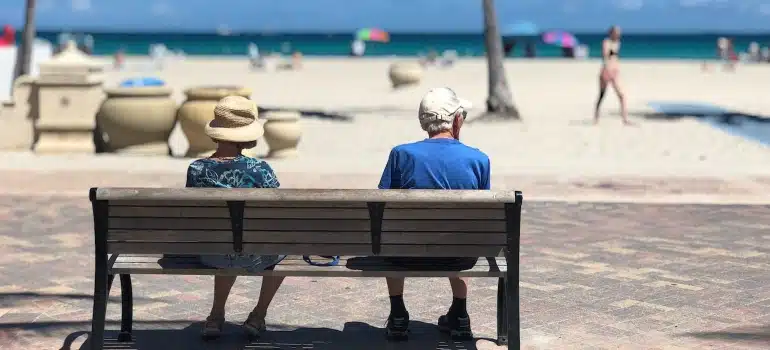
Parkland
Parkland is different from coastal Broward because it was developed later and with a deliberate suburban feel. Homes here average over $850,000 in 2025, with most inside gated, master-planned communities. Also, these neighborhoods often include golf access, fitness centers, and pools, which make them attractive to retirees who want everything close to home.
The city invests heavily in parks, and over a dozen well-maintained green spaces are spread through its neighborhoods. Residents also enjoy walking and biking trails that connect communities, something harder to find in older South Florida towns. Safety ratings are among the best in the county, and city services are consistently well-funded, which helps protect home values.
The compromise is distance. Beaches are roughly 30 minutes away, and every errand requires a car. That’s fine for buyers prioritizing safety, green space, and quieter living over coastal energy. Tamarac and Margate nearby bring lower prices but come with older housing stock, fewer amenities, and weaker resale strength.
Fort Lauderdale
Fort Lauderdale stands out because it combines cultural life, healthcare access, and waterfront living in one place. In 2025, the median home price is about $560,000, but the spread is wide: downtown condos near Las Olas push higher, while townhomes and older single-family homes inland come in lower. Also, waterfront condos and canal homes often require special access planning, which movers in Fort Lauderdale provide.
Along the Intracoastal, luxury towers attract downsizers who want ocean views with concierge service, while smaller buildings west of Federal Highway give more affordable options.
Daily living here is tied to the water. The canals make boating part of the lifestyle, and many retirees keep small crafts for recreation. Beyond the water, Las Olas Boulevard offers restaurants, art galleries, and a performing arts center that rivals Miami’s scene without the same scale or congestion. Broward Health Medical Center and Holy Cross Hospital cover everything from cardiology to oncology, a major plus for those who want top-tier care nearby.
Of course, Fort Lauderdale is not quiet year-round. Winters bring cruise traffic, higher congestion, and seasonal spikes in rental demand. Neighboring Oakland Park and Lauderdale Lakes are more affordable, but they lack waterfront access, cultural venues, and medical depth.
Weston
Weston has long been known as one of South Florida’s most carefully organized communities. In 2025, the median home price is about $720,000, with a mix of villas, townhomes, and larger houses inside neatly planned neighborhoods. Landscaping is uniform, streets are clean, and community rules are strongly enforced.
The city’s real strength for retirees is proximity to the Cleveland Clinic Florida, one of the region’s most advanced hospital systems. That single factor drives many to choose Weston over less structured nearby towns. Weston also offers miles of bike trails, community parks, and small plazas that make daily life convenient without long commutes.
HOA dues here are higher than average, but they fund consistent maintenance and community amenities that help keep property values strong. Also, HOA-controlled neighborhoods expect advanced coordination, something movers in Weston regularly manage.
Unlike Boca or Delray, Weston is not about the beach. It’s 30 minutes inland, and residents accept that trade in exchange for quieter streets and reliable upkeep. Nearby Sunrise and Plantation cost less, but they don’t match Weston’s medical access or planned layout.
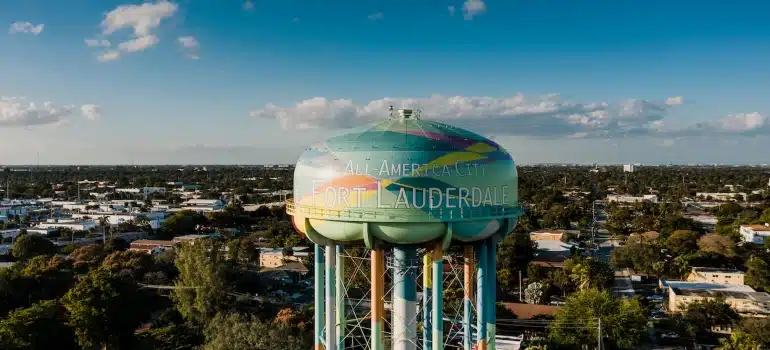
Pembroke Pines
Pembroke Pines is one of the most accessible cities in South Florida for retirees looking at price and community design. In 2025, condos and villas in 55+ developments start around $240,000, making them affordable compared to coastal markets. These communities often include pools, clubhouses, and activity calendars that support a social lifestyle, which is valuable for those moving into retirement.
The city is spread out but convenient: shopping plazas, grocery stores, and medical clinics are well-distributed, reducing the need for long drives. For specialized care, Memorial Hospital West and other Broward facilities are nearby. Many retirees find the combination of affordability and services ideal, even if the ocean is 40 minutes away.
Life here, in one of the best cities in South Florida for empty nesters, is suburban and straightforward, not flashy, but stable. People who prioritize social opportunities, healthcare, and affordability over beachfront living often choose Pembroke Pines. Miramar next door offers lower prices, but it doesn’t have the same density of 55+ housing or medical access.
Coral Springs
Coral Springs stands out in Broward County for its focus on safety, parks, and well-maintained neighborhoods. In 2025, the median home value is about $530,000, with townhomes and single-family houses offering more space than coastal cities at similar prices.
The community is known for its extensive park system, over 50 parks, plus cultural spots like the Coral Springs Center for the Arts. These features create daily routines that don’t require long drives, something many downsizers appreciate. Besides, suburban relocations run smoother with Coral Springs movers who know the local layouts.
Healthcare is close at Broward Health Coral Springs, and larger hospital systems in Fort Lauderdale are less than half an hour away. The city also enforces strict codes for property upkeep, which helps protect values and keeps neighborhoods consistent.
While not on the coast, residents can reach the beaches in about 25 minutes, trading waterfront access for calmer streets and lower insurance costs. Nearby Margate and North Lauderdale are cheaper but lack Coral Springs’ stronger safety ratings, cultural venues, and organized community services.
Safety, storms, and insurance
Moving to South Florida means planning around hurricanes and rising insurance costs. Buildings with impact-rated windows, newer roofs, and completed reserve studies are safer bets for retirees. Condo associations that meet the state’s new reserve funding rules in 2026 will offer more stability and fewer surprise assessments.
Homeowners should also review elevation maps and FEMA flood zones before signing a contract. Insurance premiums are higher here than in most states, but shopping carriers, bundling coverage, and asking about wind mitigation credits can reduce costs.
Healthcare and wellness access
Of course, one of South Florida’s biggest advantages for empty nesters is healthcare. Miami-Dade, Broward, and Palm Beach counties are home to nationally recognized systems like Baptist Health, Jackson Memorial, Cleveland Clinic Florida, and Jupiter Medical Center, for example.
Specialized care in cardiology, orthopedics, and oncology is widely available, cutting down on long trips for treatment. Beyond hospitals, urgent care centers, and telehealth services are easy to access. Fitness clubs, golf courses, and organized activities in 55+ communities support active living, too, which is just as important as medical care itself.

Housing types for empty nesters
Not everyone moving to South Florida wants the same home. Condos appeal to those who prefer low maintenance and built-in amenities like gyms or pools. Villas and townhomes provide more space with fewer upkeep demands than single-family homes. Furthermore, get HOA elevator slots secured through moving companies in Broward County once you choose your ideal home.
Gated communities add security and social activities, while 55+ neighborhoods build in clubhouses, fitness programs, and community calendars. Downsizers should always compare HOA fees, reserves, and insurance costs because these often matter more than the purchase price in the long run. Renting first is common for those unsure which area feels right.
Budgeting the move and long-term costs
The purchase price is only part of the story. HOA dues, insurance premiums, property taxes, and utilities often add thousands per year. In Miami-Dade, condo fees average around $900 per month, while in Palm Beach County can be lower but still significant.
Insurance premiums for condos and homes are often two to three times higher than the national average. Property taxes vary by county, but homestead exemptions and senior discounts can help. Factor in moving insurance, and leisure costs like golf memberships, dining, and travel when planning a long-term retirement budget.
Walkability and transport
Walkability varies widely across South Florida. Miami neighborhoods like Brickell and Coconut Grove score in the 80s and 90s, making it possible to live without a car. Delray Beach offers walkable main streets, while Boca and Coral Gables mix suburban layouts with pockets of shops and cafés.
In more suburban places like Weston or Parkland, driving is essential. Regional travel is supported by Tri-Rail and Brightline trains, while Fort Lauderdale, Miami, and Palm Beach airports keep family visits convenient.
Lifestyle and community
For many empty nesters, community is as important as housing. South Florida’s cities support strong social networks through cultural venues, volunteer programs, and community centers. Boca Raton and Delray Beach host concerts and festivals year-round.
Hollywood has its arts district, and Miami offers world-class museums and theaters. Moreover, many 55+ communities organize classes, fitness programs, and travel groups. Houses of worship, alumni clubs, and volunteering opportunities make it easier to stay socially connected.
Downsizing and space planning
Leaving a larger family home often means adjusting to smaller spaces. Empty nesters moving into condos or villas should plan ahead: decide what to keep, what to sell, and what to store. Florida’s climate also matters. Art, wine, and sensitive items should go into climate-controlled storage, so check the Florida storage rules in advance. Multi-use furniture and built-ins help maximize condo living.

Sample 7-day scouting plan
Spending a week in the area can help you narrow the search for the best cities in South Florida for empty nesters. A balanced daily plan might look like this:
- 1–2: Explore Boca Raton, Delray Beach, and Boynton Beach. Tour condos near Atlantic Avenue and compare HOA structures.
- 3: Visit Palm Beach Gardens and Jupiter. Check golf communities and tour Jupiter Medical Center.
- 4: Focus on Fort Lauderdale and Hollywood for a mix of arts and waterfront.
- 5: Visit Weston and Pembroke Pines for suburban master-planned communities.
- 6: Spend time in Miami Beach, Aventura, and Brickell to test urban living.
- 7: Walk through Coral Gables and Coconut Grove to weigh upscale against urban energy.
Such an approach shows the range of lifestyles in just one trip!
Working with professionals
Retirees benefit from choosing the right help in choosing one of the best cities in South Florida for empty nesters. Real estate agents with experience in condos and 55+ communities can flag association rules, reserve studies, and inspection reports. Next, insurance brokers can compare flood and windstorm coverage across carriers, which can save thousands.
Moreover, inspectors with coastal experience understand roof, window, and seawall issues that inland inspectors might miss. Local white glove moving and storage companies familiar with South Florida know how to handle condo elevator bookings and certificate of insurance requirements. Eventually, downsizing specialists can help you sell, donate, or move items more efficiently.
Common mistakes to avoid
Many buyers rush without reviewing the details that matter in South Florida. For example, skipping a condo’s financials or ignoring reserve funding can lead to steep assessments. Buying in flood zones without checking elevation and storm protection can drive up insurance costs.
Some underestimate noise and traffic in busy coastal neighborhoods. Others overlook HOA restrictions on rentals, pets, or renovations. Taking time to verify these details saves money and frustration, so here’s your moving checklist:
- Define a budget, including HOA fees and insurance.
- Choose three target cities or communities to explore.
- Get pre-approved or show proof of funds.
- Schedule a multi-city scouting trip.
- Tour five buildings or communities in each location.
- Request milestone inspection reports and reserve studies.
- Compare HOA coverage and special assessments.
- Book movers early and reserve condo elevators.
- Update medical records and transfer prescriptions.
- Forward mail and update voter registration.
South Florida is not one-size-fits-all. Empty nesters who want culture and walkability often look to Miami and Fort Lauderdale. Those who prefer quieter suburban planning lean toward Weston or Parkland, while coastal charm seekers consider Delray Beach, Boca Raton, or Jupiter.
So, take time to explore, compare, and weigh both housing and healthcare access before committing because that’s what turns a move into a successful long-term choice.

FAQ about the best cities in South Florida for empty nesters
Choosing the right city in South Florida often raises practical questions about housing, costs, and lifestyle. These FAQs cover what empty nesters ask most.
Q: Which South Florida city is most walkable?
A: Brickell in Miami and Atlantic Avenue in Delray Beach both score high for walkability.
Q: Where are the best 55+ communities?
A: Pembroke Pines and Boynton Beach have the largest selection of age-restricted neighborhoods.
Q: How much are HOA fees?
A: Miami-Dade averages around $900 monthly; Broward and Palm Beach range from $400 to over $1,000.
Q: Which areas have lower insurance costs?
A: Inland cities like Parkland, Weston, and Wellington typically see cheaper premiums than coastal zones.
Q: Should I rent before buying?
A: Yes, renting helps test a city’s pace, rules, and noise before committing.
Q: How does hurricane risk affect buying?
A: Oceanfront homes cost more to insure; newer inland condos face fewer storm-related expenses.
Q: What healthcare access can I expect?
A: Baptist, Cleveland Clinic, and Jupiter Medical Center offer strong hospital networks across the region.
Q: What hidden costs should I plan for?
A: Factor in insurance, HOA dues, property taxes, and special assessments beyond the purchase price.
Q: What mistakes do buyers often make?
A: Skipping HOA financial checks, ignoring insurance estimates, or underestimating traffic and noise.
